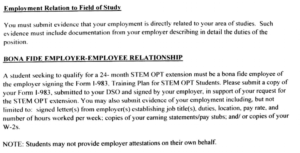
STEM Extension Requests for Evidence: Third Party Placement
As you may already know, in April 2018 USCIS updated its STEM OPT guidance webpage which limited the types of employers who can employ STEM OPT students. To read our firm’s article regarding the new STEM OPT guidance from USCIS, please click here. To recap, USCIS’ new guidance entailed the following:
- The employer that signs the Form I-983 Training Plan for STEM OPT Students must be the same entity that provides the practical training to the student, using its own personnel.
- The training experience must take place on-site at the employer’s place of business or worksite, and may not take place at the place of business or worksite of the employer’s client or customer, because ICE would lack authority to visit such sites.
- Since ICE would be unable to access the location, online or distance learning arrangements may not be used to fulfill the employer’s training obligation to the student. This means that the employer may not fulfill its training obligation by having the student make periodic visits to the employer’s place of business to receive training, while he or she is actually working at the business or worksite of a client or customer.
- Staffing and temporary agencies may seek to employ students under the STEM OPT program, but only if they provide the training at its own place of business.
We predicted that this new guidance would have a significant impact on staffing agencies and consulting firms as the new guidance from USCIS disallows students working at a third-party location while on STEM OPT. USCIS states:
Staffing and temporary agencies may seek to employ students under the STEM OPT program, but only if they will be the entity that provides the practical training experience to the student at its own place of business and they have a bona fide employer-employee relationship with the student. For instance, a student might possibly receive STEM-related training while working in such an entity’s information technology (IT) department.
Such entities may not, however, assign or contract out students to work for one of their customers or clients, and assign, or otherwise delegate, their training responsibilities to the customer or client. As noted above, the employer that signs the Form I-983 must be the same entity that provides the practical training experience to the student. Moreover, the student’s practical training experience must be provided by the employer’s own trained or supervisory personnel at the employer’s own place of business or worksite(s), to which ICE has authority to conduct employer site visits to ensure that the employer is meeting program requirements.
As a result of this new guidance, we have been receiving Requests for Evidence (RFE) on applications filed to change status to H-1B.
Additionally, we are now seeing RFE’s issued not only for H-1B applications, but also STEM extension applications. The RFE states:
By issuing this RFE, USCIS is determining whether the employer and student will have a bona fide employer-employee relationship. This means that USCIS will look into whether the employer is providing the employment and practical training to the student at its own place of business. Again, this will substantially impact employers such as staffing and temporary agencies and consulting firms. If you receive an RFE pursuant to your STEM extension application, this should not be taken lightly. Please consult a qualified attorney to discuss your response.
We will continue to update our website as we receive new information regarding this topic.
By Rahul Reddy
Rahul is the founding partner of Reddy Neumann Brown PC His practice covers employment-based immigration, in which he represents corporate clients in far-ranging industries.


